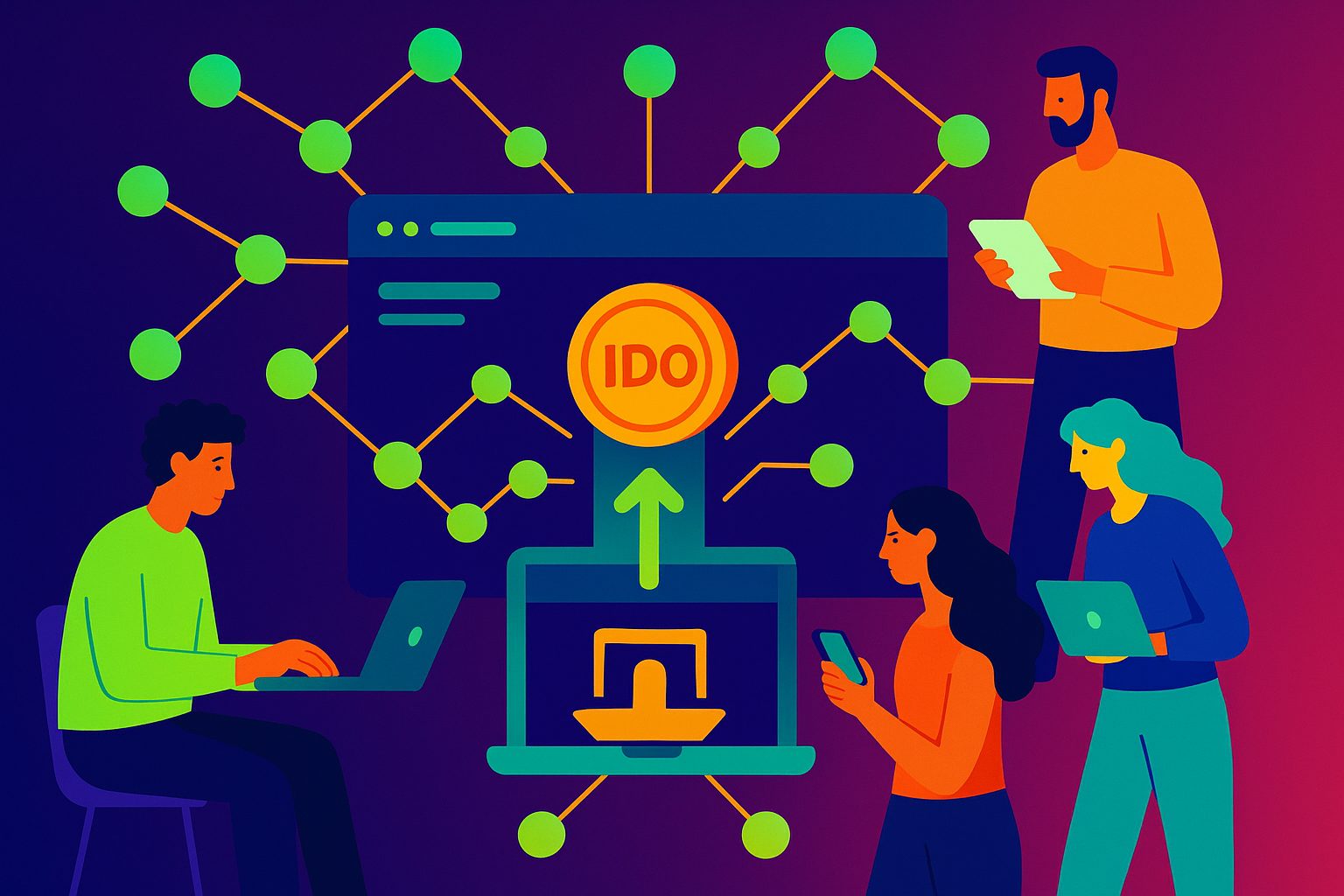Forging the Path: The Emergence of Decentralized Offerings
In the rapidly evolving landscape of digital finance, Initial DEX Offerings (IDOs) have emerged as a pivotal innovation, reshaping how projects raise capital and engage communities. Unlike traditional token sales that rely on centralized exchanges or private investors, IDOs leverage decentralized exchanges (DEXs) to foster an open, permissionless environment. From the first experimental launches on platforms like Uniswap and SushiSwap to today’s sophisticated launchpads, the IDO model has democratized access to early-stage tokens. This shift empowers everyday participants to support promising projects on their own terms, often with minimal barriers to entry. As IDOs continue to proliferate across chains—from Ethereum to Polygon, Binance Smart Chain to Solana—they are redefining the rules of engagement between developers and investors, forging a new path toward a truly decentralized future.
Key Platforms and Ecosystem Players
Every successful IDO rests upon a vibrant ecosystem of protocols, protocols, and participants. At the foundation lie DEX protocols with automated market maker (AMM) architectures that deliver instantaneous price discovery and liquidity. Complementing these are specialized launchpads—such as Polkastarter, DuckDAO, and TrustPad—that streamline the fundraising lifecycle, handling tasks like whitelisting, allocation, and token vesting. Node operators and governance token holders form another crucial layer, often determining which projects secure launchpad slots through voting mechanisms. Meanwhile, infrastructure providers offer turnkey solutions for token creation, smart contract deployment, and cross-chain bridging. Together, these elements create a dynamic tapestry where innovation flourishes. Understanding the interplay among these actors is essential for any project aiming to navigate the IDO landscape with precision and confidence.
Token Allocation Mechanics: Balancing Fairness and Fundraising Goals
At the heart of any IDO lies the token allocation design—a framework that dictates how tokens are distributed, at what price, and to whom. Projects must strike a delicate balance between rewarding loyal community members, securing strategic partnerships, and capturing sufficient capital to fuel development. Common allocation models include tiered access based on staking requirements, randomized lottery systems that ensure broad participation, and private rounds reserved for institutional backers. Some launchpads even experiment with bonding curve mechanisms, allowing contributors to influence price discovery through dynamic supply adjustments. Crafting an allocation scheme involves rigorous economic modeling to prevent whales from dominating the sale while preserving incentives for long-term engagement. When executed with transparency and foresight, token allocation mechanics become a powerful tool for fostering trust, aligning stakeholder interests, and sustaining momentum beyond the initial offering.
Smart Contract Symphony: Automating the IDO Workflow
Smart contracts are the foundational code that transforms manual, error-prone processes into streamlined, trustless operations. From minting tokens to enforcing vesting schedules and releasing liquidity, automated contracts handle every critical function with precision. The typical IDO workflow begins when a project submits its tokenomics and audit report to the chosen launchpad. Once approved, a set of contracts govern participant registration, stake verification, and fund collection. On launch day, funds are collected in a decentralized pool, participants receive their allocations, and tokens are minted to user wallets. Post-launch locks and vesting contracts then enforce token release schedules to curb immediate sell-offs. Writing and deploying these contracts demands familiarity with languages like Solidity or Rust, along with rigorous security audits to ward off exploits. A bulletproof smart contract suite not only safeguards funds but also signals professionalism and maturity to discerning investors.
Liquidity Alchemy: Harnessing AMMs for Price Discovery
Decentralized exchanges rely on automated market makers to provide continuous liquidity without order books. In an IDO context, liquidity pools are seeded with both the project’s token and a base asset—often ETH, BNB, or a stablecoin. This pool enables participants to trade immediately after launch, setting initial prices based on supply and demand dynamics. The more significant the initial liquidity, the smoother the trading experience and the less susceptible the token is to price manipulation or slippage. Some projects incentivize early liquidity providers by offering additional token rewards, creating a virtuous circle of participation and depth. By embedding liquidity directly into the launch mechanism, IDOs sidestep prolonged listing delays on centralized exchanges and foster instant market access. Mastering liquidity alchemy ensures that projects can demonstrate real-world token utility from day one and maintain healthy trading activity.
Gatekeeping Access: Whitelist, Stake, and Lottery Strategies
Although IDOs champion open participation, many launches implement gating mechanisms to manage demand and protect smaller investors. Whitelists are a popular approach, requiring users to complete tasks—such as KYC procedures, social media engagement, or community contributions—to secure a guaranteed allocation. Staking models ask participants to lock up native launchpad tokens or governance assets for a specified period, with allocation tiers determined by stake size. Lottery-based frameworks, on the other hand, allocate tickets to a broad base of users and randomly draw winners, ensuring equality of opportunity. Each model presents trade-offs: whitelists can be gamed by professional bounty hunters, staking can favor deep-pocketed speculators, and lotteries introduce uncertainty for genuine supporters. Projects that tailor their access control to community values and long-term vision ultimately foster stronger loyalty and a more balanced token distribution.
Safeguarding Trust: Audits, Compliance, and Community Confidence
In a realm rife with scams and “rug pulls,” establishing a reputation for security and transparency is paramount. Third-party smart contract audits—and, when feasible, formal verification—serve as rigorous examinations of code integrity, exposing potential vulnerabilities before they can be exploited. Publishing audit reports, complete with remediation actions, underscores a project’s dedication to security. Beyond code, teams must navigate regulatory frameworks: collecting KYC data where required, adhering to AML guidelines, and disclosing fundraising terms that may classify tokens as securities in certain jurisdictions. Proactively engaging legal counsel and maintaining open channels with regulators not only mitigates legal risk but also reassures sophisticated investors. Community trust is further cemented through clear communication: sharing periodic progress updates, livestreaming developer discussions, and creating transparent governance forums. By marrying robust security practices with proactive compliance, projects lay the groundwork for sustained credibility.
Launch Day Orchestration: From Countdown to First Trade
The crescendo of any IDO lies in its launch day performance. In the weeks leading up to T-minus zero, projects must finalize technical rehearsals, stress-test interfaces, and confirm cross-chain bridge integrations. A live countdown timer amplifies excitement, while real-time dashboards display participation metrics like total funds raised and number of unique contributors. When the clock strikes zero, smart contracts initiate fund collection, mint tokens, and inject liquidity into AMM pools. Participants watch as their contributions convert into fresh tokens, and the first trades begin to shape the market price. Behind the scenes, developer teams monitor node health, gas usage, and user support channels to swiftly resolve issues. An impeccably executed launch day creates memorable momentum, generating social media buzz, media coverage, and a surge of community energy that propels the project into its next development phase.
Nurturing Growth: Post-IDO Engagement and Ecosystem Building
An IDO marks the conclusion of fundraising, but it signals the commencement of product delivery, community expansion, and ecosystem partnerships. Immediate post-launch priorities include on-chain staking integrations, governance forum activations, and the rollout of developer tooling such as SDKs and APIs. Establishing liquidity mining programs encourages token holders to provide ongoing liquidity while reinforcing long-term commitment to the protocol. Cross-project collaborations—whether through yield farming pools, bridge integrations, or co-marketing campaigns—amplify visibility and utility. Simultaneously, transparent reporting on milestone achievements and fund allocations fosters accountability. Engaging educational content—tutorials, deep-dive webinars, and hackathons—nurtures a cohort of developers and users who can unlock new use cases. By orchestrating a holistic post-IDO strategy, teams maintain investor enthusiasm, attract new contributors, and lay the foundation for network effects.
Pioneering Tomorrow: Innovations on the Horizon
As decentralized finance matures, the IDO model continues to evolve. Future innovations may include dynamic vesting schedules that adapt to market indicators, cross-chain launchpads that orchestrate simultaneous multi-network offerings, and token bonding curves that eliminate fixed-price sales in favor of continuous auctions. Advanced identity solutions—powered by zero-knowledge proofs—could streamline KYC without sacrificing privacy, while on-chain governance modules enable token holders to vote on allocation parameters and launchpad fees. Integration with decentralized autonomous organizations promises to democratize decision-making, giving community members direct influence over project roadmaps. As Layer 2 scalability solutions reduce gas costs and enable higher-frequency micro-IDOs, even smaller niche projects will access global audiences. By staying attuned to these emerging trends, new offerings can harness cutting-edge mechanics, maintain competitive edge, and continue the relentless drive toward a more inclusive, permissionless financial future.
In “Understanding IDO Mechanics: How Decentralized Offerings Work,” we have journeyed from the genesis of decentralized fundraising to the intricate choreography of smart contracts, liquidity pools, and governance frameworks. With each step—from economic design to community engagement—projects gain the tools to orchestrate IDOs that are secure, equitable, and resilient. As the crypto space marches toward broader adoption, mastering these mechanics will be essential not only for successful crowdfunding but for building vibrant ecosystems that endure beyond a token’s initial burst of excitement. Whether you’re a seasoned developer or an aspiring entrepreneur, embracing the principles outlined here will equip you to navigate the promise and complexity of decentralized offerings, lighting the way to a more participatory financial paradigm.




